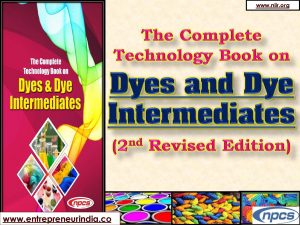The Complete Technology Book on Dyes & Dye Intermediates (2nd Revised Edition)

Introduction
Organic compounds or mixtures, as well as petroleum downstream materials, are dye intermediates that are synthesised for use in textiles, paints, plastics, paper, printing inks, and leather. Color, origin, chemical structure, and application process have all been used to classify dyestuffs into various categories. Acid orange, yellow, and acid black Dyes, Melachite green crystal, Basic magenta lumps, and Anthraquinone Type Intermediates are some of the most common Dyes Intermediates. Acid, Direct, and Reactive Dyes all need them as a raw material. It is important to safeguard these chemicals.
Related Book: The Complete Technology Book on Dyes & Dye Intermediates (2nd Edition)
A dye is a coloured material that has a particular preference for the substrate it is applied to. It’s an organic compound that’s both ionizing and aromatic. The dye is usually applied in an aqueous solution, and a mordant may be needed to improve the dye’s fastness on the fiber. Apart from that, Dye Intermediates are critical raw materials for Acid, Reactive, and Direct Dyes.
Dye intermediates are petroleum byproducts that are further refined for use in a variety of applications. They are converted into finished dyes and pigments during processing. Textiles, plastics, paints, printing inks, and paper are only a few of the industries that use dye intermediates. Apart from that, Dye Intermediates are essential raw materials for Acid, Reactive, and Direct Dyes. Hair dyes are one of the most popular uses for dye intermediates. Paraphenylenediamine and paratoluenediamine are two dye intermediates that are commonly used in hair dyes.
Related projects: Dyestuff , Dyes, Pigments and Dye Intermediates Projects
Uses of Dyes & Dye Intermediates
A natural or synthetic material that is used to modify or add colour to something. Dyes are the colouring products that give our everyday objects their colour. Dyes are used in almost every industry, from children’s toys to the fabrics you wear, from food to wood; there isn’t a single industry where dyes aren’t used commercially. Dye is a colourant that is used to give textiles, paper, leather, and other materials a permanent colour that is resistant to washing, heat, light, and other influences that the material is likely to be exposed to.
Related Videos: Textile Industry
Pigments are finely ground solids dispersed in a liquid, such as paint or ink, or blended with other materials, while dyes are finely ground solids dispersed in a liquid, such as paint or ink, or blended with other materials. The majority of dyes are organic compounds (i.e., they contain carbon), while pigments can be either inorganic or organic compounds (i.e., they do not contain carbon). Pigments are dyes that are insoluble in the medium used, and they create brighter colours.
Related Books: Dyes And Dye Intermediates, Textile Dyes & Pigments, Textile Auxiliaries, Natural, Synthetic Dyes And Pigments
Popular Dye Dyes & Dye Intermediates
- Acid orange, yellow and acid black Dyes
- Basic magenta lumps
- Melachite green crystal
- Anthraquinone Type Intermediates
- Amino Anthraquinone
- Anthraquinone-2-Carbon Acid
- 1-Nitro Anthraquinone
- 2-Chloro Anthraquinone
- 1-Methylamino Anthraquinone
- Digital Textile Printing Dyes
- Inkjet Dyes
- Metal-Complex Dyes
- Optical Brighteners
- Sublimation Dyes
- Dyes Intermediates
- Leather Dyes
- Natural Dyes
- Smoke Dyes
- Synthetic Dyes
- Leuco Dyes
- Oxidation Dyes
- Solvent Dyes
- Textile Dyes
- Basic Dyes
- Acid Dyes
- Reactive Dyes
- Direct Dyes
- Fluorescent Dyes
Projects:- Project Reports & Profiles
Market of Dyes & Dye Intermediates
Technological advances are occurring in the global dye intermediates industry. Companies are still trying to come up with new and better ways to create dye intermediates. The dye intermediates market is expected to be propelled by the development of new dye intermediates manufacturing processes and applications. The sector, however, is expected to be hindered by raw material price fluctuations.
The Indian dyes and dye intermediates market is expected to rise between 2019 and 2030, owing to the growing use of dyes and dye intermediates in the development of pigments for textiles and printing inks.
Books:- BOOKS & DATABASES
Furthermore, the expansion of industries like industrial paint, printing, plastics, and tannery is driving up demand for dyes and dye intermediates for end-use applications. Moreover, strong demand for dyes and dye intermediates from the textile industry is expected to drive growth in the Indian dyes and dye intermediates market during the forecast period.
The global market for dyes, pigments, and dye intermediates is estimated to be worth around US$ 23 billion, with dyes and pigments worth US$ 16 billion and dye intermediates worth US$ 7 billion.
Related books: – Handbook on Natural Dyes for Industrial Applications (Extraction of Dyestuff from Flowers, Leaves, Vegetables) 2nd Revised Edition
Despite the fact that the dyestuffs industry’s overall growth has slowed over the last five years, the industry is still projected to rise at a rate of about 2% per year in the coming years. The major players in this industry are China, Korea, India, Japan, and Taiwan. However, since they have focused on specialty goods, European countries have remained the largest producers in terms of market share. DyeStar, a joint venture between Hoechst AG and Bayer AG, is the world’s largest dyestuffs maker, with a 15% market share.
Market Research: – Market Research Report
Following that is BASF, which has a 12% market share. Ciba Specialty has a market share of around 11%, followed by Clariant AG with a market share of around 7%. Reactive dyes account for around 25% of total dye output globally, while disperse dyes account for 20%. In every area of the planet, these two dyes have a dominant share. On the other hand, the demand for direct vat dyes and other similar products has remained relatively stable. China, Korea, and Taiwan are strong players in disperse dyes in Asia, while India leads in reactive dye production due to the easy availability of intermediates such as vinyl sulphone.
For More Details, Click Here: https://www.entrepreneurindia.co/book-details/78/the-complete-technology-book-on-dyes-dye-intermediates-2nd-edition-